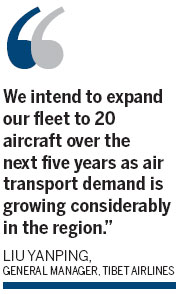Companies
Airbus flies high with Tibet Airlines order
By Liu Jie and Lu Haoting (China Daily)
Updated: 2010-08-20 09:28
 |
Large Medium Small |
LHASA - European aircraft manufacturer Airbus has consolidated its presence in China's high-altitude civil aviation market after the Lhasa-based Tibet Airlines said on Thursday that it was buying three A319s.
The new aircraft will be equipped with the Required Navigation Performance (RNP) precision-approach technology, said Airbus.

The RNP allows an aircraft to fly in a designated path between two three-dimensionally defined points in space and is ideal for the plateau airports in high-altitude regions.
Tibet Airlines zeroed in on the A319s, as they have been successful in high-altitude flights, said Liu Yanping, general manager of Tibet Airlines.
"We intend to expand our fleet to 20 aircraft over the next five years as air transport demand is growing considerably in the region," he said.
Tibet Airlines was launched in March this year. The carrier was set up with a registered capital of 280 million yuan ($40.29 million) and is a tripartite joint venture. The State-owned Tibet Autonomous Region Investment Co Ltd holds a 51 percent stake in Tibet Airlines, while Tibet Sanli Capital Investment and Tibet Ruiyi Investment Co Ltd hold 39 and 10 percent stakes.
"The high-altitude performance of the Airbus A319 has been proven by over six years of commercial operations in and out of Lhasa. The RNP validation in 2007 makes it the ideal aircraft for Tibet Airlines," said Laurence Barron, president of Airbus China.
The single-aisle aircraft will accommodate 128 passengers in a two-class configuration and also have eight first-class seats. The carrier plans to receive the planes between July and September next year and start operating the A319s on sectors within the region between 2011 and 2012. It will start flights to major destinations across China and Southeast Asia by 2013 to 2014.
China plans to have at least 244 airports by 2020 by setting up 97 new airports. More than 10 percent of the existing airports are plateau airports at altitudes above 1,500 meters, which are mainly located in western regions like Tibet and Yunnan and Sichuan provinces. Tibet alone is expected to have five civil airports by the end of this year.
| ||||
"Though it opens up new opportunities for aircraft manufacturers, it will also spur demand for tailored designs and application of RNP technology," she said.
Airbus has a lion's share of the commercial flights operating to and from Tibet. Most of the aircraft used in the region are Airbus A319s and A330s.
Boeing, the company's closest rival, is also striving to cash in on the RNP-equipped aircraft market. It was the first foreign manufacturer to introduce the technology to China in 2005.
The US company recently joined hands with the Yunnan-based Lucky Airlines and its 737-700, equipped with RNP, successfully landed at Lijiang Airport, Yunnan province, last week. That in turn, has helped the carrier get approval from the Civil Aviation Administration of China to conduct RNP flights at Lijiang airport situated 2,243 meters above sea level.
Airbus had nearly 601 Airbus aircraft in operation with Chinese carriers by the end of June this year. The company also had a 43 percent share of the total fleet in service.



